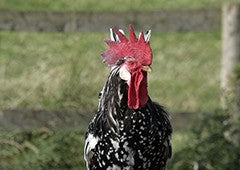Keeping chickens is a wonderful adventure imprinted with a flap of activity, a medley of clucky conversations and an egg basket overflowing with fresh bounty. Now while you may start out with just a trio of feathery friends – all look-a-likes and gifts from an enthusiastic friend or neighbour, chicken keeping is so addicting that you’ll soon find yourself becoming more and more inquisitive. Curiosity breeds interest in other chicken breeds. So, can you add new breeds to your flock? Yes. Should you add a new breed or two or more to your flock? Un-egg-quivocally!
A Mixed Breed Flock Mixes Well
Raising and keeping a flock of chickens need not be limited to a single breed. Variety is the spice that creates a flavorful vibrant flock. So many chicken breeds, so little time. In fact, there are more than 400 different breeds in existence. Feeling just a tad overwhelmed? Add into the mix all the mixed-breeds that happen by happenstance. When love is in the air, predictability flaps out the window. So, sometimes there’s no telling what’s going to hatch out of your eggs. Enter a wonderful new chicken breed for your humble little backyard flock.
Seriously though, a diverse backyard chicken flock is not only a delight, but is quite advantageous in several ways. So, let’s take a peck at the beauty and practicality of this one of a kind flap-happy flock:
- A beautiful sight to behold with colourful and varied feathers and feather patterns, feathery legs and clean legs, a myriad of differently shaped combs, bearded chins and big hair crests, fluffy round breeds and taller thin breeds. Yes, a mixed up flock is a unique and beautiful sight!
- A one of a kind egg basket overflowing with eggs of varying colours and shades.
- Personality varies among breeds, but also varies from bird to bird within a particular breed. This is both helpful and delightful. A flock full of interesting and distinct temperaments translates into a successfully functioning pecking order. Every chook has its place and there’s a place for every chook. Can you imagine a flock of all Noisy Nellies? All Shy Sadies?
And, your chicken’s individual personalities help encourage others to see that chickens are loving creatures capable of feeling, learning and understanding and not just egg producing machines or meat for your table. Plus, it’s just great fun to interact with a flock chock full of character!
- Who’s Who – being able to distinguish one chook from another is key to raising a happy healthy chicken flock. By knowing who’s who you can more easily monitor behavior and illness, you can keep track of egg production which helps in recognizing and identifying potential health issues and you can help to establish a bond with individual birds by calling them by name when you visit the chicken coop each day. Also, this helps you to know how to approach each chook whether they be shy or more friendly and social.
- Egg production through the seasons – different breeds lay better during different seasons.
Bantams + Large Fowl Breeds = A Fabulous Flock
When raising a flock of mixed breed chickens, one would have to wonder about the significance of mixing smaller bantam size chooks with larger fowl birds. Due to the fact that a bantam chicken is considerably smaller than larger breeds, weighing in at about one fourth or one fifth the size of large fowl birds, you may be concerned. Will they all get along well together? Will there be an increase in squabbles between siblings? Will the bigger birds rule and peck on the smaller birds? All valid questions, yes. And the answer is…all chooks, no matter what their body size should get along flappingly together.
That’s not to say that you won’t ever encounter some feathery sibling rivalry. All siblings, feathery or otherwise, squabble from time to time. That’s natural. In fact, one of your smaller chooks could very well be the top chook in the pecking order. Have feathers, can be feisty.
Integrating New Chooks
Ideally, it’s best to raise a flock of chickens all together from day one. As hatchlings or even pullets at Point of Lay, your birds will grow up together and bond as siblings and as a flock on the whole. However, that’s not to say that you cannot add new birds from time to time. Anytime is the right time to add a new breed or two. As long as you follow proper integration guidelines, any new chooks should be happily clucking along with their older and wiser feathery siblings in the flap of a wing.
Even with excellent care and regular monitoring of your flock, chickens do die. Unfortunately, chickens can contract diseases that show no overt symptoms until the disease has progressed to the point where it’s too late to treat the bird or there simply is no treatment. So, you may choose to add some new birds or breeds to your existing flock.
The most important thing to remember when integrating new birds into an existing flock is this:
Always isolate or quarantine all new birds for at least 30 days. This gives you ample time to observe all new birds for symptoms of disease and/or signs of external parasites and to treat them if necessary. Then once the 30 day isolation period is completed, introduce new chickens.
And, remember to always monitor the interactions between old and new chooks up close and personal until you’re sure that all is well. When you feel comfortable that your feathery siblings are getting along amicably, a simple daily check-up will do fine. Allowing all chickens to free range and mingle together helps them to get acquainted.
A Recipe for Success
Creating a happy healthy mixed breed chicken flock is like following a recipe. So, what is the recipe? Simple…add a mixture of breeds – bantam and large fowl if it tickles your feathery fancy – into a large chicken coop, mix well until all are happily interacting with one another and enjoy.
Of course, there are several factors to consider when putting together your mixed breed flock:
- Climate – some breeds tolerate extreme heat or cold temperatures better than others
- Amount of Chickens/Size of Coop – on average a single large fowl bird requires approximately 1.5 square metres of space and a bantam chicken will need about 1 square metre of space. This allows your chooks to roam freely and not feel too “cooped” up which can lead to stress. If; however, your chooks will be confined to their coop and run for the majority of the time, please allow for about 3 square metres per chicken.
- Life Expectancy – Bantams live for approximately 4-8 years; Large Fowl live for approximately 8-15 years.
- Personality and Compatibility – some breeds are just more active and flighty and some are more docile and calm. Theoretically, all should mix well together, interacting and roaming about; however, always be sure to monitor your flock daily as it’s always better to err on the side of caution.
- Eggshell color – you can literally create a rainbow of eggshells for your egg basket.
- Your personal preferences
There can be some teething problems when introducing new chickens to your flock. With different breeds having different traits and personalities, there may be tensions and clashes! Some behaviours are cute quirks for a breed and others may be a cause for concern! Like all pets, chickens can be trained to stop bad behaviours and reinforce positive ones.
Cluckily, our friends over at Chickenpedia have created an amazing Chicken Etiquette Course. This extensive online course shares useful advice on a variety of chicken behaviours. The well-structured course will also help you deal with bad behaviour and encourage positive behaviours. Keep the neighbours happy - their only complaint will be that they wish they also had chickens!
Learn how to have the best-behaved chickens in town and a harmonious flock with this beginner-friendly course. This is why I highly recommend Chickenpedia’s courses to all of my readers! They are filled with vital information that help you raise a happy, healthy flock.
Click here to check out Chickenpedia today!
The Mixed Breed Chicken Flock – A Success Story
The mixed breed flock that clucks together stays together! We’ve always had a mixed breed chicken flock. It’s such a treat to visit their coop each day and watch the colourful show – black glossy feathers flap-happily dusting the afternoon away, bright white feathers leaping awkwardly in an attempt to capture a flying insect, brown pheasant tipped feathers wandering and puttering…Uh oh, Phoebe’s headed for my song bird garden again, yellow golden feathers keeping a motherly eye open for potential dangers and reddish chestnut coloured feathers sprawled out in the warm sunshine. Ahhhh, life is good!
The best thing about a mixed breed chicken flock is that it is uniquely your own – a homemade flock for your hen home. Enjoy!
And, the best place to house your diverse backyard chicken flock is in one of our innovative and stylish coops: The perfect Penthouse, the terrific Taj Mahal and the magnificent Mansion coops are anxiously awaiting an ideal ISA Brown, an amazing Australorp, an Oh so motherly Orpington, a boldly beautiful Barred Plymouth Rock, a robust red-headed Rhode Island Red and more to transform them from coop to coop sweet coop.



















